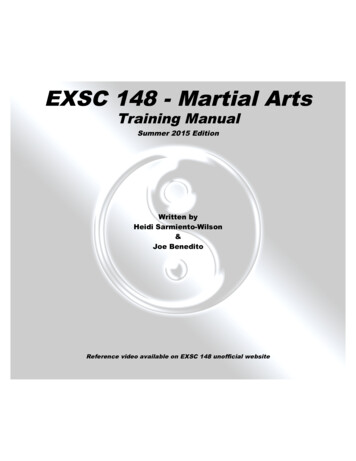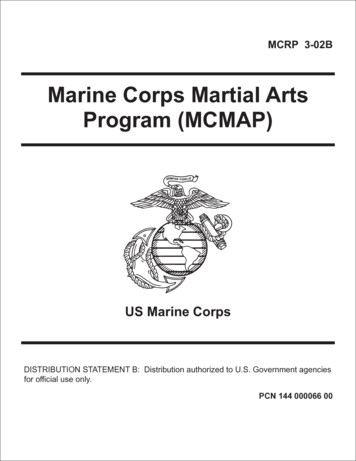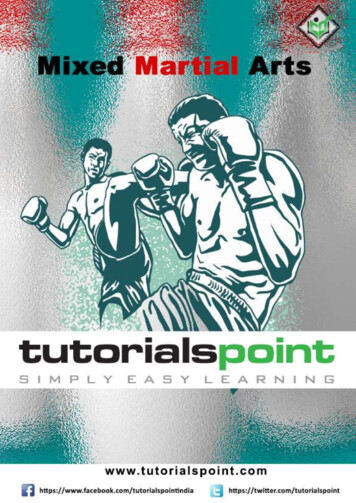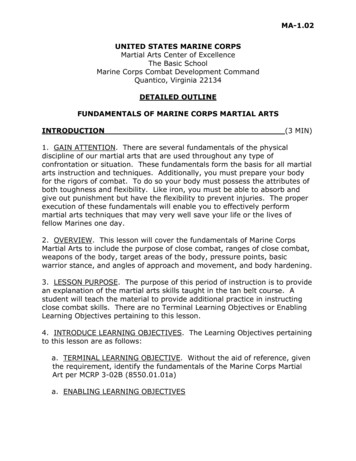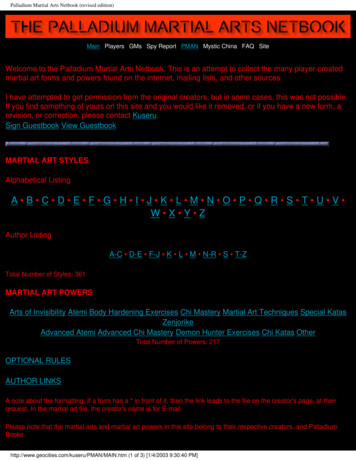
Transcription
Running head: MARTIAL ARTS TRAINING AND BEHAVIORThe Effects of Mixed Martial Arts on Behavior of Male Children with AttentionDeficit Hyperactivity DisorderByMatthew K. MorandDissertation CommitteePaul J. Meller, Ph.D., SponsorLea Theodore, Ph.D.Cheryl Camenzuli, Ph.D.Joseph R. Scardapane, Ph.D., Orals ChairpersonCharles Levinthal Ph.D., ReaderSubmitted in Partial Fulfillment of the Requirements for the Degree of Doctor ofPsychologyHofstra UniversityHempstead, N.Y. 11549May 18th, 2004Note: The oral examination is scheduled for May, 18th 2004 in the Conference Room ofthe Saltzman Center. It will be held from 11:00 AM to 1:00 PM.
Marital Arts Training iiCopyright by Matthew Klein Morand 2004All Rights Reserved
Marital Arts Training iiiAcknowledgmentsI dedicate this dissertation to my mother Gig and father Steve for teaching melove, truth, and happiness, to Ricky for his maturity, Nicholas for his intellect andMeegan for her friendship and emotion. To my extended family (Audie, Bruce, Bernie,Mima, Grandpa, Nana, Baba, and Woodmont), friends, Hashem and my martial artsfamily, thank you for supporting me all these years and for teaching me to have a “nonquitting spirit”.I am honored to have each of you in my heart my love and respect.
Marital Arts Training ivABSTRACTIn this research the effectiveness of a martial arts program two times per week atincreasing the percentage of completed homework, frequency of following specificclassroom rules, improve academic performance, and improve classroom preparation wasexplored. In addition, decreasing maladaptive behaviors including necessity forredirection to task, inappropriately calling out in class, and inappropriately leaving theseat during class were explored. Participants were male children ages 8 to 11 diagnosedwith Attention Deficit Hyperactivity Disorder.Schoolteachers completed a behavior checklist both initially during the baselineperiod and throughout the 12-week study to measure the effectiveness of bothintervention groups and the non-intervention group on the behaviors of AD/HD children.A single subject design using multiple baselines across conditions was employed in thisstudy. Participants were assigned to a martial arts intervention, exercise intervention, orcontrol group condition and data was collected on the behaviors exhibited in school.Results of this study were determined by a comparison between pre scores andpost scores on the rating scale. Five of seven hypotheses were supported. Martial Artswas proven to increase percentage of homework completion, academic performance, andpercentage of classroom preparation while decreasing the number of classroom rulesbroken and times inappropriately leaving the seat. This study lends empirical support tomartial arts as a positive intervention for children with AD/HD. Results of the study arediscussed in terms of future interventions in the physical education classroom or in aprivate setting to help children control symptoms associated with AD/HD.
Marital Arts TrainingvTable of ivTable of ContentsvList of TablesviiiList of FiguresixList of AppendicesxiChapter I.1INTRODUCTION AND REVIEW OF THE LITERATUREIncidence and Prevalence of AD/HD2History of AD/HD3Predominantly Inattentive Type4Predominantly Hyperactive-Impulsive Type5AD/HD Predominantly Combined Type5Diagnosis of AD/HD6Behavioral Difficulties Associated with AD/HD6Academic Difficulties Associated with AD/HD8Social Skills Difficulties Associated with AD/HD9Interventions for Children with AD/HD10Behavioral and Cognitive-Behavioral Interventions11Social Skills Training14
Marital Arts Training viLimitation of Behavioral, Cognitive Behavioral Techniques and SocialSkills Training16Medication17Combining Behavioral and Psychopharmacological Techniques20Benefits of Exercise as a Treatment22Benefits of Martial Arts on Behavior27History and Types of Martial Arts27Martial Arts Versus Other Forms of Physical Activity30Summary31Hypotheses32Chapter II. nt variable38Dependent Variable38Procedure38Martial Arts Intervention42Minutes 1-3 Meditation and KIAI44Rationale for inactive meditation45Rationale for KIAI and OSU45Minutes 3-5 Explanation of Defensive Stance46
Marital Arts Training viiMinutes 5-40 Intensive Martial Arts Training Drills47Rationale for Intensive Martial Arts Training Drills47Minutes 40-50 Close Range Defense Moves48Rationale for Close Range Defense Moves48Minutes 50-60 Mediation and Stripes48Rationale for Mediation and Stripes49Exercise Intervention ProgramRationale for Exercise Intervention ProgramChapter III. RESULTS495051Hypothesis One51Hypothesis Two57Hypothesis Three60Hypothesis Four63Hypothesis Five66Hypothesis Six69Hypothesis Seven72Chapter IV. DISCUSSION75Limitation of the Study87Clinical Implications88Implications for Future Research89References94Appendices108
Marital Arts Training viiiList of TablesPageTable 1.Descriptive Statistics and Effect Sizes of DependentVariables.52
Marital Arts Training ixList of FiguresPageFigure 1.Proposed multiple baseline across conditions interactionFigure 2.Individual Participant’s Daily Results for Martial Arts, Exercise andControl Groups for Question OneFigure 3.63Individual Participant’s Daily Results for Martial Arts, Exercise andControl Groups for Question FourFigure 10.61Individual Participant’s Daily Results for Martial Arts, Exercise andControl Groups for Question FourFigure 9.60Individual Participant’s Daily Results for Martial Arts, Exercise andControl Groups for Question ThreeFigure 8.58Individual Participant’s Daily Results for Martial Arts, Exercise andControl Groups for Question ThreeFigure 7.57Individual Participant’s Daily Results for Martial Arts, Exercise andControl Groups for Question TwoFigure 6.55Individual Participant’s Daily Results for Martial Arts, Exercise andControl Groups for Question TwoFigure 5.54Individual Participant’s Daily Results for Martial Arts, Exercise andControl Groups for Question OneFigure 43764Individual Participant’s Daily Results for Martial Arts, Exercise andControl Groups for Question Five66
Marital Arts TrainingFigure 11.Individual Participant’s Daily Results for Martial Arts, Exercise andControl Groups for Question FiveFigure 12.Individual Participant’s Daily Results for Martial Arts, Exercise andControl Groups for Question SixFigure 13.69Individual Participant’s Daily Results for Martial Arts, Exercise andControl Groups for Question SixFigure 14.6770Individual Participant’s Weekly Results for Martial Arts, Exercise andControl Groups for Question Seven72x
Marital Arts Training xiList of AppendicesPageAppendixA. Diagnostic Categorizations change of the DSM-III, DSM-IIIR and DSM-IV 108B.DSM-IV Criteria for AD/HD110C.Medication Information112D. Overview of Nine Behavioral Approaches Useful in Treating AD/HD115E.Behavior Checklist120F.Cover Letter for Request of Participants121G. Consent for Participation122H. Demographic Information Sheet125I.Martial Arts Daily Checklist Session Log126J.Intervention Rating Profile-15127K. Individual Participant Daily Results for Martial Arts, Exercise and ControlGroup Question OneL.129Individual Participant Daily Results for Martial Arts, Exercise and ControlGroup Question Two132M. Individual Participant Daily Results for Martial Arts, Exercise and ControlGroup Question ThreeN.135Individual Participant Daily Results for Martial Arts, Exercise and ControlGroup Question Four138
Marital Arts Training xiiO.Individual Participant Daily Results for Martial Arts, Exercise and ControlGroup Question FiveP.Individual Participant Daily Results for Martial Arts, Exercise and ControlGroup Question SixQ.141144Individual Participant Weekly Results for Martial Arts, Exercise and ControlGroup Question Seven147
Marital Arts Training1Chapter I. IntroductionResearch suggests that Attention Deficit Hyperactivity Disorder (AD/HD) is oneof the most common disorders found in children, totaling 30% to 50% of child referrals tomental health services (Barkley, 1996; Popper, 1988). Substantial impairments in peer,family, and academic functioning can be attributed to children with AD/HD (Barkley,1996; Hinshaw, 1992). Therefore, it is essential to establish efficacious methods to treatsymptoms associated with AD/HD.Past research has been focused on interventions including medications, cognitivebehavioral and behavioral therapies, social skills training programs, and appliedbehavioral analysis to help alleviate symptoms associated with AD/HD (The MTACooperative Group, 1999). Few of these controlled studies have examined theeffectiveness beyond three months of short-term treatments (Spencer, et al., 1996;Swanson, 1993; Pelham & Murphy, 1986; Hinshaw, Klein, & Abikoff, 1998; Pelham,Wheeler, & Chronis, 1998).Scientific progress has been significantly slowed by the lack of a single,consistent, and standard research protocol for case identification of AD/HD (Lesesne,Abramowitz, Perou, & Brann, 2000). The Diagnostic and Statistical Manual of MentalDisorders-Fourth Edition Text Revision (DSM-IV-TR) (2000), indicates that laboratorytests and neurological or attentional assessments have yet to be validated for diagnosingAD/HD (DSM-IV-TR, 2000). It has yet to be established which cognitive processes areresponsible for AD/HD.A multitude of interventions have been utilized with AD/HD but have had mixedresults. One area with limited research is exercise, specifically martial arts, and its effects
Marital Arts Training2on the maladaptive and adaptive behaviors of children exhibiting AD/HD symptomology.This study will address the efficacy of a martial arts intervention program on behaviors ofmale children age 8 to 11 who have been diagnosed with attention deficit/hyperactivitydisorder- combined type.Incidence and Prevalence of AD/HDDiagnostic difficulties have affected the ability to come to a consensus as to theincidence and prevalence of AD/HD. The differences have been noted throughout theliterature and continue to be disputed (Barbaresi et al., 2002). Through greater mediaexposure, heightened awareness of parents, and availability of effective treatments, thenumber of children identified with AD/HD has risen over the past decade. Thus, it isdifficult to determine whether the incidence or prevalence of AD/HD has risen over thepast decade. Difficulties in estimating prevalence exist because some estimates onlyinclude diagnosed people while others include undiagnosed people who unknowinglyhave the condition. Incidence rates, much like prevalence rates may not be comparableeither. Government notifications, physical or hospital diagnoses, and various othermethods may result in different incidence rates.Barbaresi et al. (2002) reviewed medical and school records for clinical diagnosisof AD/HD and identified cases as “definite”, “probable”, “questionable”, or “notAD/HD”. The four subtypes were categorized on the basis of; clinical diagnosis andsupporting documentation; without diagnosis but two types of supporting documentation;without diagnosis with one type of supporting documentation; and without diagnosis andwithout supporting documentation respectively. The cumulative prevalance at age 19years was 16% at its highest when “definite”, “probable”, and “questionable” cases were
Marital Arts Training3included and 7.4% at its lowest when only the “definite” AD/HD categorization wasincluded. In a similar study, Cohen, Becker, & Cambell (1990) indicated thatpreadolescent children’s prevalence of AD/HD is between three to five percent. Otherresearchers have estimated that the prevalence of Attention Deficit/HyperactivityDisorder is three to seven percent in school age children depending on the nature of thepopulation sampled and the method of ascertainment. The method in which the data wereobtained and the nature of the population sampled helps to explain the varying rates ofAD/HD (DSM-IV-TR, 2000). The National Institute of Mental Health (NIMH) (2003)suggested that AD/HD is estimated to affect 3 to 5 percent of school-age children andoccurs three times more often in boys than in girls.History of AD/HDThe nomenclature AD/HD as an identifiable diagnostic category surfaced in thelate 1960’s. Prior to that time, many terms were used to describe the syndrome includingsuperactive, minimal brain dysfunction, hyperkinesis, and hyperactivity (NIMH, 2003).IN the DSM-II (1968), hyperkinesias or motor excess was the defining characteristic ofthe disorder. The term Attention Deficit Disorder was created to underline the importanceof inattentiveness that is often but not always accompanied by hyperactivity. Thissurfaced a decade later when it was included as a syndrome in the DSM-III. The termAD/HD emphasized the inclusion of hyperactivity within the diagnosis as it returned inthe 1987 revisions of the DSM-III-R. There was delineation within the classification ofAD/HD in the DSM-IV to include a predominance of one pattern (inattention orhyperactivity/impulsivity) of symptoms for at least the last 6 months or more (NIMH,2003).
Marital Arts Training4Lahey et al. (1994) suggests a high degree of overlap of previous and currentdefinitions of AD/HD between previous diagnostic categorizations such as the DSM-III,DSM-IIIR and the DSM-IV (See Appendix A). Three types of diagnostic categories havebeen established in the DSM-IV according to the presence of symptoms in the individual.The DSM-IV-TR (2000) delineates Attention Deficit Hyperactivity Disorder into threesubtypes: Attention-Deficit/Hyperactivity Disorder-Predominantly Inattentive Type;Attention-Deficit/Hyperactivity Disorder- Predominantly Hyperactive-Impulsive Type;and Attention-Deficit/Hyperactivity Disorder- Combined Type. For a diagnosis ofAD/HD to be made, the onset of symptoms must occur before age seven, be at least sixmonths in duration, must be present in at least two settings, and there must be clearevidence of impairment in social and academic functioning.Predominantly Inattentive TypeInattention may be the predominant characteristic for some children with AD/HD.The Predominantly Inattentive type includes behaviors such as the inability to followthrough with directions, having high distractibility and forgetting details of daily routines.Children categorized as having AD/HD, Predominantly Inattentive Type (ADHD-I) mustmeet at least six DSM-IV criteria for inattention, that are disruptive and inappropriate fordevelopmental level for at least a six month period. Some of the symptoms includebehaviors such as the inability to follow through with directions, having highdistractibility and forgetting details of daily routines. In addition, less than six symptomsof hyperactivity-impulsivity must be present (American Psychiatric Association, 2000)(See Appendix B).
Marital Arts Training5Predominantly Hyperactive-Impulsive TypeAttention Deficit/Hyperactivity Disorder, Predominantly Hyperactive-ImpulsiveType (AD/HD-H/Im) is defined in the DSM-IV-TR, as a disorder in which at least sixcriteria for hyperactivity-impulsivity are present for at least a six months period and thatare disruptive and inappropriate for developmental level. In addition, less than sixsymptoms of inattention may be present. Symptoms of hyperactivity include a child’sinability to remain seated, often fidgeting with hands or feet, having trouble playingquietly, and often “on the go” or acting as if “driven by a motor” (American PsychiatricAssociation, 2000) (See Appendix B).AD/HD Predominantly Combined TypeChildren who meet the criteria for both ADHD-I and ADHD-H/Im may bediagnosed as children with AD/HD Predominantly Combined Type” (ADHD-C)(American Psychiatric Association, 2000). Children with ADHD-C maintain at least sixsymptoms of each hyperactivity-impulsivity and inattention. A diagnosis of any of thethree AD/HD subtypes requires that the symptoms that cause impairment were presentbefore age seven years; some impairment from the symptoms is present in two or moresettings (e.g. at school/work and at home); there must be clear evidence of significantimpairment in social, school, or work functioning; and the symptoms do not happen onlyas a factor of a pervasive developmental disorder, schizophrenia, or other psychoticdisorder.Diagnosis of AD/HDBarkley (1990) suggests that there are discrepancies in diagnostic proceduresresulting from professionals having different conceptualization of AD/HD. The National
Marital Arts Training6Institute of Mental Health (2003) suggested that well tested diagnostic interview methodscoupled with diagnosis based on history and observable behaviors in the child’s usualsettings are reliable procedures to diagnose AD/HD. Dulkan and Benson (1997) suggestthat to establish a correct diagnosis of AD/HD a comprehensive medical evaluation of thechild must be conducted. Furthermore, The National Institute for Mental Health (2003)states that the key elements to diagnosis include medical, developmental, school,psychosocial, and family histories coupled with a thorough history of the presentingsymptoms, differential diagnosis, and possible comorbid conditions. DuPaul and Stoner(1994) suggest that school professionals must be knowledgeable regarding appropriateevaluation procedures even though the diagnostic criteria for this disorder have beendeveloped and published primarily by physicians (i.e., American Psychiatric Association,1987). School psychologists must be cognizant of community-based professionals whocould provide an appropriate evaluation or be able to conduct the evaluation of ADHDthemselves.Behavioral Difficulties Associated with AD/HDThere are a multitude of behaviors associated with AD/HD that vary according todevelopment and age. These associated features include but are not limited to lowfrustration tolerance, outbursts in class, temper tantrums, loss of possessions, moodlability, poor self-esteem, lack of focus, inability to maintain attention and concentration,lack of academic achievement, poor social skills, and family and school conflict (DSMIV-TR, 2000). These difficulties are noticeable in the academic realm (DuPaul & Stoner,1994; Mannuzza, Klein, & Bessler, 1993; Sealander et al., 1997, DSM-IV-TR, 2000) andthe social realm (Wheeler & Carlson, 1994, Center for Disease Control, 2003). Barkley
Marital Arts Training7(1997) states that behavioral inhibitions can be linked to the disruption of five otherneuropsychological abilities, four being executive functions and the fifth being that of themotor control system. These abilities depend upon inhibition for their own efficientexecution and are the central impairment in AD/HD. Campbell et al. (1994) usedresistance-to-temptation and delay-of-gratification tasks to evaluate 69 boys identified asAD/HD in comparison to 43 non-AD/HD control children. The children with AD/HDwere permitted to play with a battery-operated train that visited four rides in a pretendamusement park. When the experimenter left the room, children were instructed not totouch the toy in her absence. Behavioral coding was recorded for how often the childrentouched the toy in the experimenter’s absence and latency to the first touch. Resultsindicate that ADHD boys touched the toy approximately twice as often as the controlboys, 35% sooner, and were less likely to use the delay strategy of attending to andtalking about the toy than did control boys.Barkley (1997) suggests that difficulty in inhibiting prepotent responses is largelycomprised in behavioral inhibition. Poor inhibition in AD/HD is evidenced by responsesto a go/no-go task. Barkley describes this task as one that requires the inhibition of amovement when a second cue is provided as subjects emit a motor response to an initialcue, such as a finger tap, as fast as possible when cued to do so. Inhibiting responses to ano-go signal has been routinely found in subjects with AD/HD (Iaboni, Douglas, &Baker, 1995; Milich, Hartung, Martin, & Haigler, 1994; Shue & Douglas, 1989;Trommer, Hoeppner, Lorber, & Armstrong, 1988; Voeller & Heilman, 1988).
Marital Arts Training8Academic Difficulties Associated with AD/HDResearchers and other professionals agree that the prevention of academicunderachievement and other negative effects on the lives of children, adolescents, andadults affected by ADHD can be accomplished by early intervention (DuPaul & Stoner,1994; Mannuzza, Klein, & Bessler, 1993; Sealander et al., 1997). Students with AD/HDmay attain their potential when entering into the workplace or postsecondary education ifcounselors address the needs (Schwiebert, Sealander, & Bradshaw, 1998).There are numerous symptoms associated with AD/HD and academic difficultieswhich lead to a shorter amount of time in years of schooling on average and poorervocational achievement for AD/HD individuals than their peers (DSM-IV-TR, 2000).Searight, Nahlik, and Campell (1995) found that children with AD/HD are more likely tohave speech/language problems in early childhood, while affected children frequentlypresent with poor academic functioning, distractibility, disruptiveness, and inappropriatepeer relationships during middle childhood. Conduct and substance abuse problems,employment and interpersonal relationship maintenance, and demonstrating pooracademic functioning may be found in AD/HD adolescents and adults (Searight, Nahlik,and Campell, 1995).Furthermore, Barkley (1990) noted that adolescents with hyperactivity haveacademic outcomes that are significantly poorer than outcomes for adolescents withoutAD/HD. Additionally, Barkley concluded that adolescents affected by the disorder aremore likely to fail a grade, be suspended or expelled from school, or score at significantlylower levels of academic achievement on standard tests of math, reading, and spellingwhen compared with their classmates without AD/HD.
Marital Arts Training9Social Skills Difficulties Associated with AD/HDThere are numerous ways in which the social behaviors of children with AD/HDare problematic (Landau & Moore, 1991). Sheridan, Susan, and Candace (1996) suggestthat children with AD/HD have behaviors that are deficient in subtle ways with regard tostyle, content, and appropriateness. Furthermore, Sheridan et al. state that negativeinterpersonal experiences occur resulting from their high social activity level. Missedopporuntunities for social learning occur because children with AD/HD tend to beaggressive and therefore are placed at-risk for being disliked and excluded. Frederick &Olmi (1994) suggest that most of the maladaptive behaviors typically found in childrenwith AD/HD explain the various maladaptive social relationships these childrenexperience, especially considering that these inappropriate behaviors are manifested inschool. Increasing demands for individuals to conduct themselves in a socially acceptablemanner may make the symptoms of AD/HD more problematic during the adolescentyears (Schwiebert, Sealander, & Dennison, 2003). These researchers stated that theadolescent with AD/HD must cope with issues of sexual identity, peer acceptance,emerging physical changes, courtship, and dating. They hypothesized that this only addsto the distress that the adolescent is undertaking.Research conducted by Wheeler & Carlson (1994) suggests that the mostfrequently cited behavior problems for teacher and parents of children with AD/HD aresocial difficulties. The Center for Disease Control (2003) states that children may oftenbe perceived as shy or withdrawn by peers when they have predominantly inattentiveAD/HD. Additionally, the Committee for Disease Control (CDC) indicates that peer
Marital Arts Training 10rejection may be a result of the symptoms of aggressive behavior exhibited by childrenwith impulsivity/hyperactivity difficulties.Significant adjustment problems in various venues such as frequent defiance andnoncompliance with authority figures and rules; significant antisocial behaviors includingphysical fighting, stealing, and vandalism; and difficulty establishing peer relationshipsmay be displayed by adolescents with AD/HD (Barkley, 1990; Sealander, Eigenberger,Schwiebert, Wycoff, & Ross, 1997). Furthermore, behavioral disinhibition includesexcessive talkativeness, loud and abnoxious vocal noises, difficulty following instruction,more trouble deferring gratification and resisting temptation, tendency to blurt outincorrect verbal responses, and frequent disruptions of others’ conversations (APA, 1994;Barkley, 1997; Campbell, Pierce, March, Ewing, & Szumowski, 1994; Mililich, Landau,Kilby, & Whitten, 1982).Interventions for Children with AD/HDDifferent approaches have been utilized to diminish the symptoms associated withAD/HD. The MTA Cooperative Group (1999) conducted a review of interventionsconsidered by professionals to be beneficial treatments for AD/HD. Interventionsmentioned in this study included medications and behavioral therapies. Social skillstraining programs and applied behavioral analysis have also been used to help theindividual better control their behaviors. Each intervention has varying degrees of successand failure.Rapport (1992) researched the historical progression of strategies used to managethe symptoms of AD/HD. He suggested that a progression occurred dating from the1930’s clinical trials of psychoactive medication to contingency management techniques
Marital Arts Training 11of the 1960’s. He further discussed the dominant movement towards the use ofpsychostimulant treatment combined with behavioral interventions in the 1970’s. Finally,the 1980’s and 1990’s research of Rapport focused on epidemiological and diagnosticclassification issues and psychostimulant medication as the mainstay strategy for treatingAD/HD. Rather than relying solely on single treatment modalities as will be discussedfurther below, optimal management of AD/HD typically requires a multifaceted and longterm treatment approach (DuPaul & Stoner, 1994). Relatively few non-behavioraltreatment programs have been implemented successfully with AD/HD children asidefrom pharmacological interventions (Frazier & Merrell, 1997).Behavioral and Cognitive-Behavioral InterventionsBehavioral and cognitive-behavioral interventions have been used in classroomenvironments for children with AD/HD. These interventions are important as six to eighthours a day, five days per week, school-aged children are in school and classroomsettings. The behavioral characteristics of these children frequently interfere withclassroom learning and socially acceptable behavior. Imparting the knowledge and skillscomprising the curriculum and teaching children to behave in a manner consistent withsocial, cultural, and organizational requirements are more demanding when it involveschildren diagnosed with AD/HD (DuPaul and Stoner, 1994). The teaching of adaptivebehaviors has been attempted by a multitude of behavioral and cognitive behavioralinterventions as outlined below.DuPaul and Stoner (1994) state that especially when behavior management isconcerned, classroom-based interventions tend to consist of manipulations of consequentevents (i.e., reinforcers and punishers). The use of positive reinforcement, response cost,
Marital Arts Training 12time outs, and applied behavior analysis has been emphasized in intervention research.These researchers suggest that behavior interventions may capture the child’s attentionthrough enhancement of the stimulation or motivational value of the task at hand andtherefore increase the overall level of appropriate classroom behavior.Contingency management procedures such as token reinforcement programs canbe effective in producing positive behavior changes in children. These include schoolbased token reinforcement systems designed to identify problematic areas of the child,create a targeted intervention, select target behavior and secondary reinforcer (i.e.,tokens) to be used, determine the values of target or goal behaviors, develop a list ofprivileges for which tokens can be exchanged, and demonstration of the program toinvolved children (DuPaul and Stoner, 1994). Dupaul, Guevermont, and Barkley (1992)investigated the efficacy of response-cost contingencies alone and in combination withdirected-rehearsal procedures. The researchers used a within-subject reversal design withmultiple-baseline components across academic work periods and concluded thatstudents had marked improvements in task-related attention and reductions in adverseAD/HD symptoms as evidenced by academic performance measures, behavioralobservations, and teacher ratings.Dunlap et al. (1994) researched choice making as an intervention to promoteadaptive behavior for students with emotional and behavioral challenges. In their firstanalysis, reversal designs showed that the choice-making conditions increased taskengagement and reduced disruptive behavior for participants when they were givenchoices from menus of academic tasks, pertinent to educational objectives in English andspelling. The second analysis demonstrated the choice-making condition of the first
Marital Arts Training 13analysis was superior to baseline and yoked control phases as determined by levels oftask engagement and disruptive behavior for a third participant.Strategies incorporating self-monitoring, self-reinforcement, and/or selfinstruction are strategies of self-management interventions for AD/HD (Barkley, 1989).Christie, Hiss, and Lozanoff (1984) researched modification of inattentive classroombehavior with hyperactive children by having three hyperactive participants participate ina training program to teach them how to self-record their behavior in a regular classroom.Each participant was signaled when to record his behavior at intervals of time convenientfor the teacher in a regular classroom setting. Data suggested reduction in inattentive andinappropriate classroom behavior and increased
Martial Arts Intervention 42 Minutes 1-3 Meditation and KIAI 44 Rationale for inactive meditation 45 Rationale for KIAI and OSU 45 Minutes 3-5 Explanation of Defensive Stance 46 . Marital Arts Training vii Minutes 5-40 Intensive Martial Arts Training Drills 47 Rationale for Inten
